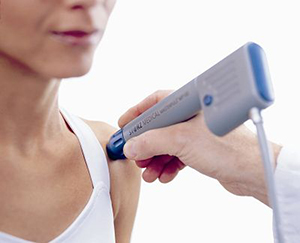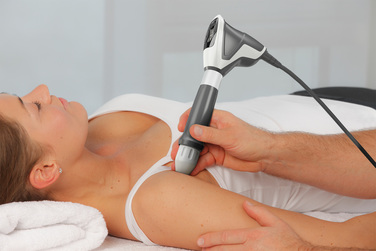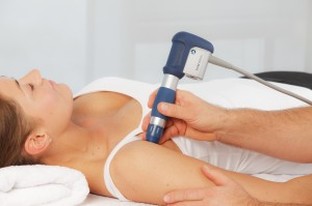SHOULDER CONDITIONS
Frozen Shoulder
Frozen shoulder, also called adhesive capsulitis, occurs when the shoulder capsule becomes inflamed, inhibiting motion of the shoulder bones within the joint. This results in stiffness, pain, and reduced mobility of the shoulder. A common problem with frozen shoulder is that the symptoms create a damaging feedback loop; patients often stop using the joint normally due to pain, but this lack of movement can lead to more stiffness and even less motion. Over time, this results in even more pain and an inability to do simple movements, such as reaching behind or overhead.
Oftentimes, frozen shoulder occurs:
The Journal of Shoulder and Elbow Surgery published a study in 2014 outlining the efficacy of shockwave therapy in comparison to traditional oral steroids. In the study, it was found that patients receiving shockwave therapy for their frozen shoulder symptoms had better shoulder scoring and range of motion after 4 weeks when compared to the steroid-receiving patients, and also had better daily living scores after 6 weeks than those in the steroid group. At Granville Physio, your therapist can use shockwave therapy to relieve frozen shoulder pain, and encourage increased mobility through further shockwave sessions and personally tailored exercises.
Oftentimes, frozen shoulder occurs:
- after a previous injury or surgery
- between the ages of 40-70
- due to favoring the shoulder, or failing to maintain a full range of motion
The Journal of Shoulder and Elbow Surgery published a study in 2014 outlining the efficacy of shockwave therapy in comparison to traditional oral steroids. In the study, it was found that patients receiving shockwave therapy for their frozen shoulder symptoms had better shoulder scoring and range of motion after 4 weeks when compared to the steroid-receiving patients, and also had better daily living scores after 6 weeks than those in the steroid group. At Granville Physio, your therapist can use shockwave therapy to relieve frozen shoulder pain, and encourage increased mobility through further shockwave sessions and personally tailored exercises.
Bursitis
A bursa is a small, synovial fluid-filled sac. There are more than 150 bursae throughout the body, and they provide a cushioning between the bones and tendons/muscles surrounding our joints. Healthy bursae provide lubrication to joints, allowing for smooth gliding and painless movement.
Bursitis is the inflammation of these bursae, due to irritation or infection. When the bursae become inflamed, they swell with fluid and put pressure on the joints. This results in painful or restricted movement of the joint, as well as muscle stiffness. Shockwave therapy has been shown to be an effective treatment option for bursitis, as an alternative to corticosteroid injections or in conjunction with home training strategies.
In a systematic review by the British Medical Bulletin, it was found that 4 months after treatment began, 34% of home training patients, 49% of corticosteroid patients, and 64% of shockwave patients had returned to previous levels of activity. Furthermore, 15 months after treatment began, these numbers had improved to 74-80% for shockwave and home therapy, a drastic improvement on corticosteroid injection patients at only 48%. Shockwave therapy is becoming an increasingly attractive long-term recovery option for bursitis pain.
Bursitis is the inflammation of these bursae, due to irritation or infection. When the bursae become inflamed, they swell with fluid and put pressure on the joints. This results in painful or restricted movement of the joint, as well as muscle stiffness. Shockwave therapy has been shown to be an effective treatment option for bursitis, as an alternative to corticosteroid injections or in conjunction with home training strategies.
In a systematic review by the British Medical Bulletin, it was found that 4 months after treatment began, 34% of home training patients, 49% of corticosteroid patients, and 64% of shockwave patients had returned to previous levels of activity. Furthermore, 15 months after treatment began, these numbers had improved to 74-80% for shockwave and home therapy, a drastic improvement on corticosteroid injection patients at only 48%. Shockwave therapy is becoming an increasingly attractive long-term recovery option for bursitis pain.
Calcific Rotator Cuff Tendinopathy
Calcific rotator cuff tendonitis is a condition where small (usually 1-2 cm) calcific deposits accumulate within the tendons of the rotator cuff of the shoulder (supraspinatus, infraspinatus, and subscapularis). These calcium deposits are similar to bone, but have a consistency more like toothpaste. When this happens, it can irritate the tendon, cause a build-up of pressure in the area, and increase the impingement experienced in the joint.
Calcific rotator cuffs are usually extremely painful. Oftentimes, patients report the pain as suddenly appearing one day, with no distinct trauma or previous injury in the area. The entire shoulder area can become extremely tender to the touch, and the pain is often debilitating in regards to motion and normal functioning. Some cases may resolve on their own without intervention, many persist and require extensive treatment or surgery.
However, at Granville Physio, your physiotherapist can use shockwave therapy to disperse the calcific deposits and ease your pain! In a study published in the Journal of the American Medical Association, it was found that in patients receiving shockwave therapy, calcific deposits were 60% removed at 6 months, and 86% removed at 12 months. In comparison, patients who received no intervention showed only 11% disappearance at 6 months, and 25% after 12 months. These findings suggest shockwave can provide a drastic recovery improvement when applied to calcific rotator cuff tendonitis!
Calcific rotator cuffs are usually extremely painful. Oftentimes, patients report the pain as suddenly appearing one day, with no distinct trauma or previous injury in the area. The entire shoulder area can become extremely tender to the touch, and the pain is often debilitating in regards to motion and normal functioning. Some cases may resolve on their own without intervention, many persist and require extensive treatment or surgery.
However, at Granville Physio, your physiotherapist can use shockwave therapy to disperse the calcific deposits and ease your pain! In a study published in the Journal of the American Medical Association, it was found that in patients receiving shockwave therapy, calcific deposits were 60% removed at 6 months, and 86% removed at 12 months. In comparison, patients who received no intervention showed only 11% disappearance at 6 months, and 25% after 12 months. These findings suggest shockwave can provide a drastic recovery improvement when applied to calcific rotator cuff tendonitis!







